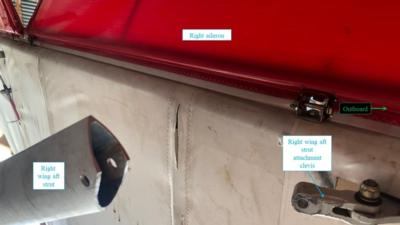Sun, Apr 24, 2022
Pilot’s First Flight In The Accident Airplane After It Was Repaired
Location: Chula Vista, CA Accident Number: WPR22LA149
Date & Time: April 8, 2022, 15:30 Local Registration: N3156D
Aircraft: Dietrich Ryan S-4 Coyote 1 Injuries: 1 None
Flight Conducted Under: Part 91: General aviation - Personal
On April 8, 2022, about 1530 Pacific standard time, an experimental amateur-built Rans S4 Coyote 1, N3156D, was substantially damaged when it was involved in an accident near Chula Vista, California.

The pilot was the sole occupant and was not injured. The airplane was operated as a Title 14 Code of Federal Regulations Part 91 personal flight.
The pilot stated that he completed a preflight inspection of the airplane with his mechanic and then started the airplane and taxied to runway 27. He aligned the airplane with the runway centerline and then gradually advanced the throttle for takeoff. When the airplane was about 300 ft into the takeoff roll the pilot applied back pressure to the flight stick and the airplane started to transition into a climb. However, the airplane immediately began a right roll when it was only a few feet above the ground. The pilot rapidly applied left flight stick, but the airplane continued to roll to the right. He then pushed the flight stick forward and applied left rudder to remain in ground effect and increase his airspeed, which slowed the right roll.
The airplane was to the right of the right runway edge at an altitude of about 8 ft agl as it approached the departure end of the runway when the pilot decided he had insufficient control of the airplane to continue the flight safely. At this point he reduced the engine power to idle and placed the airplane in a left crab, which allowed him to maintain a level attitude. As he pulled back on the flight stick to begin a landing flare he felt the right wing drop again. The airplane touched down on the right main landing gear, which immediately collapsed and the right wing impacted the ground.
Postaccident photographs from the Federal Aviation Administration showed substantial damage to the right wing.
The pilot stated that the airplane suffered a hard landing about 9 months prior, which resulted in damage to the right wing and right main landing gear. This was the pilot’s first flight in the accident airplane after it was repaired. Further inspection of the wreckage revealed that the right-wing strut was not bolted to its attachment clevis at the right wing.
More News
With Testing Soon Complete, Launch Preparations Begin in Earnest Sierra Space's Dream Chaser has been put through the wringer at NASA's Glenn Armstrong Test Facility in Ohio, but w>[...]
Takeoff Roll The process whereby an aircraft is aligned with the runway centerline and the aircraft is moving with the intent to take off. For helicopters, this pertains to the act>[...]
“We’re proud of the hard work that went into receiving this validation, and it will be a welcome relief to our customers in the European Union. We couldn’t be mor>[...]
"Aircraft Spruce is pleased to announce the acquisition of the parts distribution operations of Wag-Aero. Wag-Aero was founded in the 1960’s by Dick and Bobbie Wagner in the >[...]
IDENT Feature The special feature in the Air Traffic Control Radar Beacon System (ATCRBS) equipment. It is used to immediately distinguish one displayed beacon target from other be>[...]
 Sierra Space Repositions Dream Chaser for First Mission
Sierra Space Repositions Dream Chaser for First Mission ANN's Daily Aero-Term (05.10.24): Takeoff Roll
ANN's Daily Aero-Term (05.10.24): Takeoff Roll Aero-News: Quote of the Day (05.10.24)
Aero-News: Quote of the Day (05.10.24) Aero-News: Quote of the Day (05.11.24)
Aero-News: Quote of the Day (05.11.24) ANN's Daily Aero-Term (05.11.24): IDENT Feature
ANN's Daily Aero-Term (05.11.24): IDENT Feature



